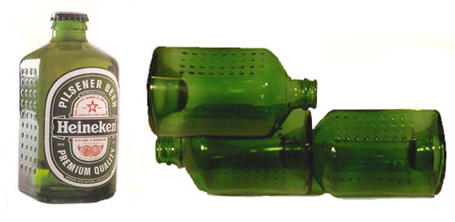 Inhabitat: Upcycling is a 21st century term, coined by Cradle to Cradle authors William McDonough and Michael Braungart, but the idea of turning waste into useful products came to life brilliantly in 1963 with the Heineken WOBO (world bottle). Envisioned by beer brewer Alfred Heineken and designed by Dutch architect John Habraken, the “brick that holds beer” was ahead of its ecodesign time, letting beer lovers and builders alike drink and design all in one sitting.
Inhabitat: Upcycling is a 21st century term, coined by Cradle to Cradle authors William McDonough and Michael Braungart, but the idea of turning waste into useful products came to life brilliantly in 1963 with the Heineken WOBO (world bottle). Envisioned by beer brewer Alfred Heineken and designed by Dutch architect John Habraken, the “brick that holds beer” was ahead of its ecodesign time, letting beer lovers and builders alike drink and design all in one sitting.
The final WOBO design came in two sizes – 350 and 500 mm versions that were meant to lay horizontally, interlock and layout in the same manner as ‘brick and mortar’ construction. One production run in 1963 yielded 100,000 bottles some of which were used to build a small shed on Mr. Heineken’s estate in Noordwijk, Netherlands. One of the construction challenges “was to find a way in which corners and openings could be made without cutting bottles,” said Mr. Habraken.
Today, the shed at the Heineken estate and a wall made of WOBO at the Heineken Museum in Amsterdam are the only structures where the ‘beer brick’ was used. As to the remaining WOBO’s it’s not clear how many exist, or where, but the idea, even some four decades later, remains a lasting example in end-use innovation.
HEINEKEN WOBO: The brick that holds beer [Inhabitat]
Beer Brick
(Visited 9 times, 1 visits today)
I suppose you could fill the bottles with sawdust or something to solve two problems at once: suddenly my house is no longer see-through, and it improves the insulative qualities. Nevertheless, the process of emptying the bricks may be counter-productive: if I’ve been drinking that much beer, I may not be in the best shape for construction with glass bricks.
It’s like Legos but, for adults.